Anglian Rivers Sea Trout Project
The Anglian Rivers Sea Trout Project is a collaborative partnership between anglers, fishery scientists and managers, conservationists, landowners and local communities. Its aim is to conserve and improve the habitat and wildlife of four North Norfolk Rivers (the Glaven, Stiffkey, Burn and Nar), and the Great Eau and Welland in Lincolnshire, using sea trout stocks as a barometer of river health. Its aim is to deliver a prioritised programme of conservation projects to improve river habitat and the wildlife connections between habitats.
The project was conceived in 2007 and founding partners include Wild Trout Trust; Environment Agency; Natural England; Centre for Environment, Fisheries & Aquaculture Science (CEFAS); Norfolk Wildlife Trust; Holkham Estate and Holkham Fishing Club; River Glaven Conservation Group; Association of Rivers Trusts and Mr Andrew Green (River Burn). More recently the Norfolk Coast Partnership and Norfolk Rivers Trust have become involved. Membership of the partnership is open to organisations, groups and individuals who wish to contribute to the projects aims and objectives. Funding for the project has been provided by the Environment Agency, Natural England plus many contributions in kind from other partners; the project has also been able to access matched funding from the EU Interreg Living North Sea Project.
Although sea trout are known to enter all these rivers, research indicates that many of the sea trout which inhabit
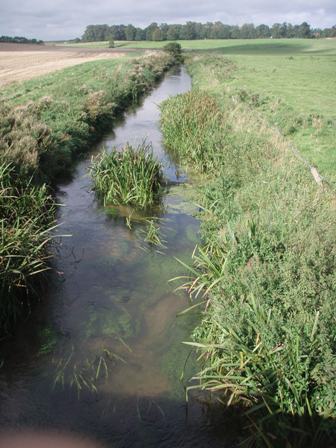
Anglian coastal waters originate from the rivers of north-east England and south-east Scotland such as the Esk, Wear, Coquet, Tyne and Tweed. Licensed fisheries along the Anglian coast therefore exploit sea trout from a number of rivers (“mixed stocks”), which is why this fishery is being phased out in line with international policy to protect the most vulnerable stocks, which would certainly include those originating in Anglian rivers.
The basic physical characteristics of the Anglian rivers are similar, having headwaters flowing through wooded hills of glacial debris over chalk and then across low-lying former washlands to enter the sea via tidal sluices. They have been modified over the centuries by channelisation, drainage and clearance of the floodplain, and regulation of flow by mills, weirs and sluices. The upper reaches of the rivers are relatively steep with reasonable habitat for trout: natural banks, meanders, deep pools and shallow gravel riffles and a diversity of plant and invertebrate species. Eel, lamprey, bullhead and coarse fish are also present in the rivers.
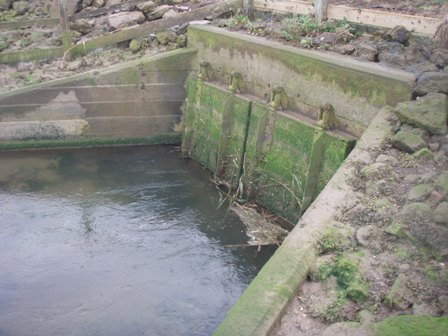
The diversity of habitats has however been greatly modified in recent decades through changes in farming and land management practices, and in response to flood-risk policies. The most recent and pernicious impact was the widening and dredging during flood defence schemes in the 1970s and 1980s. The result was a lowered river bed lacking in gravel, the loss of riffle and pool habitat and bankside wetland habitat, increased siltation, and poor submerged plant growth and impoverished fish and invertebrate communities. Although sea trout are known to enter the lower reaches of Anglian rivers their opportunities are limited by tidal gates and sluices, and their progress upstream to suitable spawning areas is blocked by weirs and mills.
The Anglian Sea Trout Project has three phases:
1. Reviewing existing information on trout stocks in these rivers, and identifying factors that are limiting stocks, and prioritising these for action.
Progress to date:
- Anglian Rivers Sea Trout Project: Phase 1 Report by Dr. Mike Pawson, in conjunction with CEFAS
2. Designing detailed conservation plans to enhance sea trout stocks, preparing detailed habitat and barrier surveys and project plans, and designing appropriate monitoring programmes to measure progress.
Progress to date:
- Initial survey of barriers to fish migration (Rivers Stiffkey, Glaven, Nar, Burn) by Mike Beach
- WTT habitat assessments
- Detailed design for fish pass and river restoration, River Glaven, Glandford Mill
- Detailed design for bypass channel, river and lake restoration, River Glaven, Bayfield Hall
- Detailed options appraisal for fish passage improvements, River Nar, Narborough
- Habitat and migration barrier assessment on the River Welland
- Appraisal of water level / flow management régime in Welland-Maxey Cut
- Detailed designs for fish passes on River Welland structures
3. Delivering a prioritised programme of capital conservation projects including fish passes or barrier removal, and habitat restoration and protection.
Progress to date:
- Gravel riffle installation, River Stiffkey
- Tidal sluice fish pass installation, River Stiffkey
- River restoration and re-naturalisation project, River Glaven, Hunworth
- Fish migration easement installed, Pentney Abbey, River Nar (Environment Agency project)
- River re-modelling (pool creation), River Nar, Narborough (Environment Agency project)
- River restoration, re-naturalisation and fish pass installation at Glandford Mill, River Glaven
- Creation of a new, naturalised river channel for the River Glaven bypassing Bayfield Lake and culvert
Wild Trout Trust contact: Tim Jacklin
Gravel Riffle Installation, River Stiffkey
The River Stiffkey is a small chalkstream in North Norfolk, running into the sea near the village of Stiffkey. The river
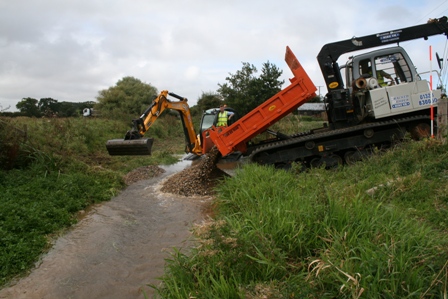
channel is artificially straight and has been since at least the early C19th. The straight, overwide channel is prone to accumualtion of sediment (washed in from the surrounding sandy soils) and growth of emergent vegetation, such as reeds and rushes; because of this, regular maintenanace dredging has been carried out for many years. The combination of these factors impacts greatly upon in-stream habitat and has limited trout populations; one of the main reasons is the absence of clean, silt-free gravel of the correct size for trout spawning.
In 2009, working with the landowner, Holkham Estate, the Wild Trout Trust installed ten gravel riffle areas, using approximately 700 tonnes of gravel and creating 300 metres of shallow riffle habitat. The river banks were re-
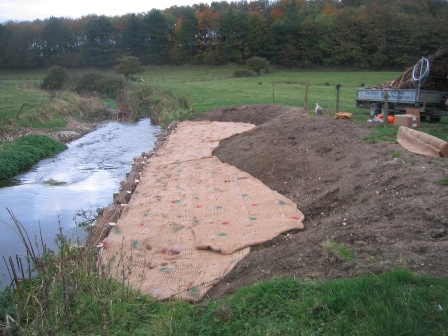
profiled alongside the introduced gravel to create low marginal berms and stockproof fencing and drinking points were installed. The project was planned and managed by Tim Jacklin of WTT, with funding provided by the Environment Agency and Holkham Estate. Steve Henson of Norfolk Wildlife Trust carried out a water vole survey prior to works commencing to ensure this protected species was not harmed during the works.
Since completion, a number of trout redds have been seen each winter on the introduced gravels. Luke Mitchell, a PhD student at University College London, is carrying out studies on the use of gravels for spawning and egg survival rates, compared with redds in natural gravel areas.
Tidal sluice fish pass, River Stiffkey
Many East Anglian rivers enter the sea through a gate or sluice which closes at high tide to protect reclaimed or defended land from flooding. Such flow control structures can be significant barriers to the free movement of fish which migrate for feeding, breeding or shelter at different times or seasons. Sea trout are a good example, but other species include eel, salmon, lampreys, shad, flounder and mullet.
There are various methods of increasing the “window of opportunity” for fish to pass across these structures without compromising the tidal control function. The gates can be made so they do not fully close, or the closing deliberately delayed, or an aperture made in the gate which allows a greater degree of water exchange. The aperture could remain open permanently or designed to shut some time after the main gate has closed. All options need to be carefully
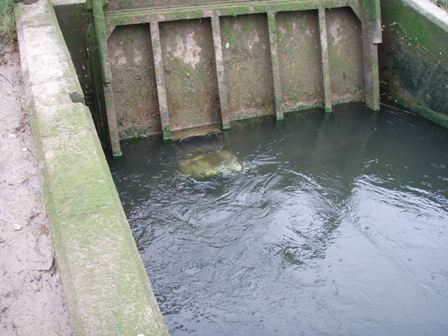
considered and hydraulic modelling undertaken to assess the impact upon the flood defence function of the structure.
On the River Stiffkey, a “pet door” type aperture was installed in the main tidal flap gate. This remains open after the main gate shuts on a rising tide, then closes much more gradually via a door attached to an adjustable flotation device. It was designed, manufactured and installed by Sandy Cowie and the Environment Agency’s Operation Delivery Team. The Wild Trout Trust gained the necessary consents and permissions for the installation and engaged a consultant to model the effects on upstream water levels and ingress of salt water. Research on the effectiveness of the fish pass is being carried out by Gill Wright, a PhD student at Southampton University.